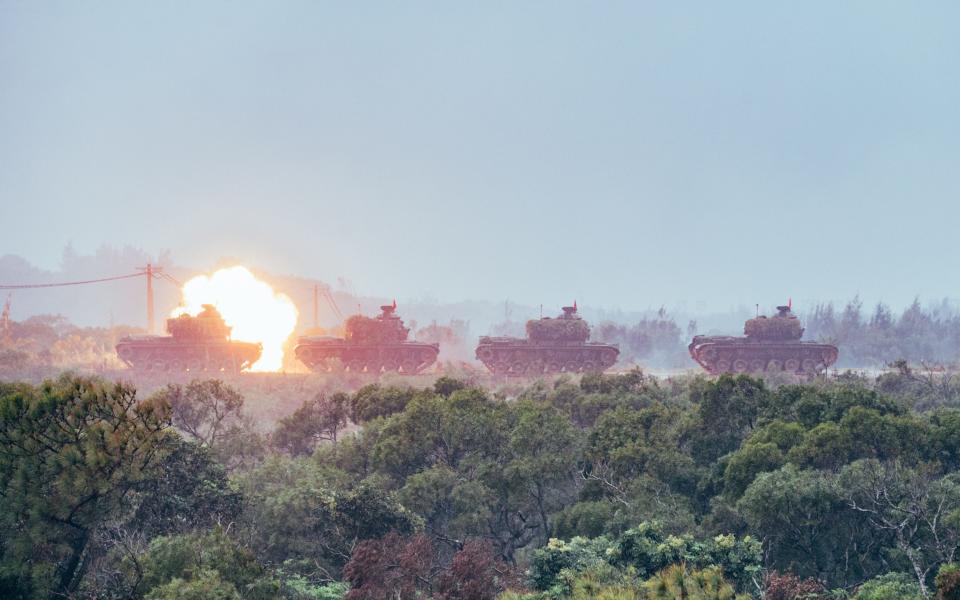Taiwan plans to fight on even after a Chinese landing
Russia’s invasion in Ukraine could teach Taiwan how to use its tanks to repel a Chinese invasion.
Before Russian forces attacked in February 2022, some analysts questioned the usefulness of heavy, lumbering tanks on a high-tech battlefield dense with drones, missiles and mines. But the fighting in Ukraine has underscored the enduring value of the heavily-armored firepower that tanks provide. Even when they’re under relentless assault from above.
The most recent tank battle in the Russia-Ukraine war might be the most telling. When Russian infantry closed in on the ruins of Avdiivka, a key Ukrainian stronghold in eastern Ukraine’s Donbas region, Ukraine’s Soviet-vintage tanks rolled out to meet them.
In one dramatic clash, a 42-ton, three-person T-64 tank with a 125-millimeter main gun and hundreds of millimeters of armor rolled down on Russian infantry bunkering in houses on Avdiivka’s outskirts. Shrugging off a blast from a mine or missile, the tank leveled structure after structure and sent the surviving Russians running.
It was the kind of fight a lighter vehicle might not have won. And the kind of fight that could be critical to Taiwan’s defense if Chinese forces manage to battle their way across the Taiwan Strait and land on the island.
Taiwan anticipates that it may have to fight on its own shores. It’s not for no reason that, in 2019, Taipei dropped $2.2 billion for 108 of the latest American-made M-1A2 tanks. The 71-ton, four-person M-1s with their 120-millimeter guns and thick composite armor will complement Taiwan’s 200 older, and much lighter, M-60 and CM-11 tanks with their 105-millimeter guns.
The tanks form the steely core of Taiwan’s counter-landing force. If the Chinese fleet successfully crosses the 90-mile-wide Taiwan Strait – definitely not a foregone conclusion given the threat that Taiwanese and American missiles and submarines pose to a vulnerable amphibious fleet – and puts troops ashore, Taiwanese forces would aim to swiftly counterattack and push the Chinese forces back into the sea.
In that way, Taiwan’s brigades are “critical to the outcome of the operation,” Mark Cancian, Matthew Cancian and Eric Heginbotham, analysts for the Washington DC-based Center for Strategic and International Studies, concluded in a January study.
Other observers disagree. “High-end equipment like F-16 aircraft, heavy tanks and submarines are useless” for the defense of Taiwan, Raymond Kuo, a political scientist at the RAND Corporation in California, wrote in January. “They are likely to be destroyed in any invasion’s opening salvo.”
Ukraine proved heavy forces can survive bombardment, however. Tipped off by Nato intelligence that the Russian attack was coming, the Ukrainian military dispersed its tanks and other heavy equipment. The Ukrainian army’s most powerful tank unit, the 1st Tank Brigade, was intact when Russian regiments rolled in. And for more than a month, the brigade successfully defended the city of Chernihiv, north of Kyiv.
Taiwan isn’t Ukraine, of course, and China isn’t Russia. But if Ukraine’s tanks could survive the initial bombardment and go on to win battles, Taiwan’s probably could, too.

Even the rapid proliferation of tiny, explosives-laden drones doesn’t alter that calculation.
“The extensive use of [unmanned aerial systems] – for all the changes it has wrought – has yet to prove decisive, and has not pushed traditional ground combat capabilities from the battlefield,” analyst Nick Reynolds wrote for the Royal United Services Institute in London.
It might not even matter that most of Taiwan’s tanks are old. Yes, the M-60s are from the 1970s. But Russia and Ukraine have both deployed tanks that are older than that. A big gun and thick armor count for a lot, even when they’re decades-old.
The advanced age of many of Taiwan’s tanks might actually confer advantages. Tanks tend to get bigger with each successive generation, so Taipei’s oldest tanks – its CM-11s – are also its smallest, at just 55 tons apiece. Some observers describe them as “medium” tanks.
“In complex terrain, medium motorized forces may fit operational needs,” Reynolds wrote. They’re especially useful in crowded cities, where bigger tanks might not be able to maneuver. Taiwan is one of the most urbanized countries in the world.
Taiwan’s oldest tanks might not last long against China’s newest tanks, including its 60-ton, three-person Type 99s with their 125-millimeter main guns. But according to Rob Lee, an analyst with the Foreign Policy Research Institute in Pennsylvania, tank-on-tank duels in Ukraine are “rare.”
Instead, tanks usually do what those Ukrainian tanks did around Avdiivka recently: they fight infantry. An exposed rifleman doesn’t care whether the steel behemoth rolling toward him weighs 55 tons or 71 tons. It’s a deadly threat either way.
There are lots of ways to kill tanks, of course. In the early weeks of the Russian invasion, Ukrainian infantry packing American-made Javelin missiles knocked out hundreds of Russian tanks. Nearly two years later, drones might be the biggest killers of tanks in Ukraine.
But both sides are adapting even their smallest and oldest tanks: adding layers of add-on armor and fitting tiny radio-jammers that can ground drones before they strike. Simple overhead protection grids can stop the smaller kinds of drone, and allow tank crews to ride with their hatches open at least some of the time.
Many observers imagine a potential war between China on one side, and Taiwan and its allies on the other, as a primarily air and naval conflict. And they’re not wrong. But if and when Chinese troops hit the beaches, it becomes a ground conflict, too – one in which Taiwanese tanks could play a critical role.
But tanks will be more useful if Taiwan heeds the lessons of the Ukraine war, and spreads out its tanks, reinforces them with jammers and extra armor and deploys them against infantry.

